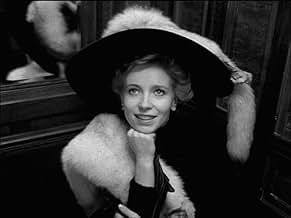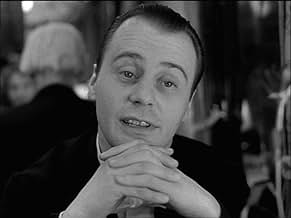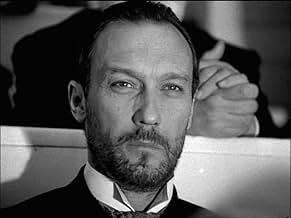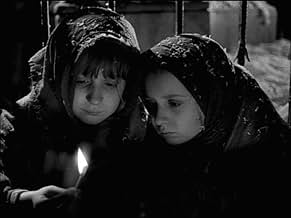AVALIAÇÃO DA IMDb
7,0/10
2,1 mil
SUA AVALIAÇÃO
Adicionar um enredo no seu idiomaTwo twin sisters, who grew up separately, Dóra, a pseudo-aristocrat, and Lili, an anarchist bomber, are reunited through Z, a mysterious traveller of the luxurious Orient-Express.Two twin sisters, who grew up separately, Dóra, a pseudo-aristocrat, and Lili, an anarchist bomber, are reunited through Z, a mysterious traveller of the luxurious Orient-Express.Two twin sisters, who grew up separately, Dóra, a pseudo-aristocrat, and Lili, an anarchist bomber, are reunited through Z, a mysterious traveller of the luxurious Orient-Express.
- Prêmios
- 1 vitória no total
Avaliações em destaque
My Twentieth Century is a wonderful movie, starring a beautiful and talented actress. This movie is worth repeated viewings not only because of the cinematography, but for the story as well.
I saw it as a few stories. Set at the turn of the century, the movie explores the lives of twin girls, separated early in life. It is a quiet movie with little action. But the images will stay with you long after a viewing.
I saw it as a few stories. Set at the turn of the century, the movie explores the lives of twin girls, separated early in life. It is a quiet movie with little action. But the images will stay with you long after a viewing.
In My Twentieth Century, the world begins to move electrically - dramatically, beautifully shown in electric dance costumes, marching bands and mirrored halls, spurred by a sad-faced (I really liked his face) actor as Edison, intoning toward the end that As god is magnificent for his creation, man is magnificent in learning how to harness it (not quite the line, but best I can do).
Meanwhile, twin orphan girls fall asleep, like the match girl in the Andersen story, hoping a lighted match will warm them on a snowy eve. Stars and a miraculous donkey lead well-dressed men to carry them to safety but in separate directions of compass and life. Later, one of them, now a poor anarchist, drops her copy of Kropotkin's "Mutual Aid" in the snow where a man finds it, reads it's message of cooperation and play among animals (in great distinction to the then popular capitalist theory of 'social darwinism' - "survival of the fittest" and "red in tooth and claw") through the night and becomes entwined in the narrative as he meets one of the young women and then the other, none of them knowing of the twin presence.
Kropotkin's observations, while brought in by a revolutionary, seemed to be the narrative of a playful counterpoint to the technologically modern world. I didn't see his words used as narrative as a turning back so much as a development that goes arm in arm with the other. His observations of rabbits "so drunk with play" they lack "fear of the fox" are juxtaposed with scenes of the man and the young women as they tryst happily and alternately take offense. While the anarchist seemed put off by the man's brusque manner (he had justifiably mistaken her for the more libidinous sister) the affairs seemed modern and innocent in consequence - no french lieutenant's woman fate, no scarlet letter. While Edison prepares to send a message by wire around the world, the young women and their man unite (it's vague but...) and wake to scenes of white pigeons in flight also carrying messages. Edison even confronts one before sending his own message.
Meanwhile, twin orphan girls fall asleep, like the match girl in the Andersen story, hoping a lighted match will warm them on a snowy eve. Stars and a miraculous donkey lead well-dressed men to carry them to safety but in separate directions of compass and life. Later, one of them, now a poor anarchist, drops her copy of Kropotkin's "Mutual Aid" in the snow where a man finds it, reads it's message of cooperation and play among animals (in great distinction to the then popular capitalist theory of 'social darwinism' - "survival of the fittest" and "red in tooth and claw") through the night and becomes entwined in the narrative as he meets one of the young women and then the other, none of them knowing of the twin presence.
Kropotkin's observations, while brought in by a revolutionary, seemed to be the narrative of a playful counterpoint to the technologically modern world. I didn't see his words used as narrative as a turning back so much as a development that goes arm in arm with the other. His observations of rabbits "so drunk with play" they lack "fear of the fox" are juxtaposed with scenes of the man and the young women as they tryst happily and alternately take offense. While the anarchist seemed put off by the man's brusque manner (he had justifiably mistaken her for the more libidinous sister) the affairs seemed modern and innocent in consequence - no french lieutenant's woman fate, no scarlet letter. While Edison prepares to send a message by wire around the world, the young women and their man unite (it's vague but...) and wake to scenes of white pigeons in flight also carrying messages. Edison even confronts one before sending his own message.
electricity...the stars talking...a dog with electrodes on its head...a whore and a terrorist...the pigeons...the donkey...siberia...what the freakin hell? this one either went right over my head. nothing else to say about this one but i'm supposed to fill up 4 lines. rating -6/10.
I have the LaserDisk. For those who didn't understand, it's an allegory for the 20th Century of Hungary. The two leading female roles are representative of a dichotomy of Hungarian National thought. A key scene is the one in which the leading lady (Dora?) allows herself to have sex with (or maybe seduces?)the male lead (who represents the Hungarian people/nation itself) and then allows herself to be re-serviced on board the ship (Fiume) by the German. Hungarian history is replete with a love/hate relationship with Germany. The Hungarian people have been very religious (read the lyrics to the Hungarian National Hymn), hence the intervention of the angels to protect the two girls. Hungary, in all its national aspirations and doubts, is protected by God.
The explanation is the scene in the hall of mirrors, in the angels' discussion of the male lead's dilemma, i.e. of loving both girls (or bring trapped by the Hungarian national dichotomy) but not understanding why or how to resolve his problem.
The ending is confusing. It appears to be a boat's passage into a limitless lake or ocean, perhaps suggesting an uncertain future for the nation and its people.
The explanation is the scene in the hall of mirrors, in the angels' discussion of the male lead's dilemma, i.e. of loving both girls (or bring trapped by the Hungarian national dichotomy) but not understanding why or how to resolve his problem.
The ending is confusing. It appears to be a boat's passage into a limitless lake or ocean, perhaps suggesting an uncertain future for the nation and its people.
At the turn of the century, there were terrorists with bombs, a magic called electricity and of course, there was love, represented by twin sisters born - one a courtesan, the other a political feminist. It was a time when everything was black and white. This movie does what movies are supposed to do - to make you dream and think and feel about our experiences on earth. Like great dreams, you may not fully understand them, until you reflect and see it again.
First time I saw this at the SF Film Fest was a 1989 preview. Ten minutes into it the projector shut down. "We apologize, but we started with the second reel first. We don't have enough time to show it now, but check back for a reschedule." Talk about feeling confused and having low expectations with other films to see, for some reason I came back; I suppose to get my money's worth. Maybe it put the hook in me. So it opens with a dreamlike child's instrument playing, and stock footage of a circus entertainer putting his head in a canon, holding a torch to the fuse - all playing in reverse cycles. The film challenges you deceptively with old film tricks, but they are well thought out. A modern director would plod epic beginning - Edison's first public display of electric light. Enyedi as light as a snowflake directs us to the first magnificent scene set at night. People in period 1880's clothing see light bulbs for the first time. Playing Stars and Stripes, a band marches forward, mostly Negroes lit up, powered by a following horse-drawn cart holding Edison's sinister sounding generator. Electricity! With creative liberties, the director swiftly takes us from New Jersey to Hungary, where twins are born to sell matches in the night snow only to be driven away by a constable. They huddle to strike a flame; curious, innocent faces are brightened. Matches!
The director uses the spark of these twins as two different female natures to advance us into the birth of the twentieth century. A must see for anyone who values cinema.
First time I saw this at the SF Film Fest was a 1989 preview. Ten minutes into it the projector shut down. "We apologize, but we started with the second reel first. We don't have enough time to show it now, but check back for a reschedule." Talk about feeling confused and having low expectations with other films to see, for some reason I came back; I suppose to get my money's worth. Maybe it put the hook in me. So it opens with a dreamlike child's instrument playing, and stock footage of a circus entertainer putting his head in a canon, holding a torch to the fuse - all playing in reverse cycles. The film challenges you deceptively with old film tricks, but they are well thought out. A modern director would plod epic beginning - Edison's first public display of electric light. Enyedi as light as a snowflake directs us to the first magnificent scene set at night. People in period 1880's clothing see light bulbs for the first time. Playing Stars and Stripes, a band marches forward, mostly Negroes lit up, powered by a following horse-drawn cart holding Edison's sinister sounding generator. Electricity! With creative liberties, the director swiftly takes us from New Jersey to Hungary, where twins are born to sell matches in the night snow only to be driven away by a constable. They huddle to strike a flame; curious, innocent faces are brightened. Matches!
The director uses the spark of these twins as two different female natures to advance us into the birth of the twentieth century. A must see for anyone who values cinema.
Você sabia?
- CuriosidadesVoted as one of the "12 Best Hungarian Films" ("New Budapest 12") by Hungarian filmmakers and critics in 2000.
- Erros de gravaçãoThe film takes place around 1900. In the projection room scene, among Méliès' films, there is an extract from "The General" by Buster Keaton which was shot in 1926. That is 26 years later.
- ConexõesFeatured in Senhoras e Senhores: Corte Final (2012)
- Trilhas sonorasMacbeth, Act 3: Coro e ballabile
Ondine e silfidi""
Written by Giuseppe Verdi
Performed by Andrea Mate, Budapest Symphony Orchestra, Hungarian Radio and Television Chorus, Istvan Gati, Janos Bandi, Janos Tóth, Katalin Pitti, Kolos Kováts, Lamberto Gardelli, Mária Zádori, Peter Kelen, Piero Cappuccilli, Sylvia Sass, Tamás Bátor
Principais escolhas
Faça login para avaliar e ver a lista de recomendações personalizadas
- How long is My Twentieth Century?Fornecido pela Alexa
Detalhes
- Data de lançamento
- Países de origem
- Idioma
- Também conhecido como
- My Twentieth Century
- Locações de filme
- Empresas de produção
- Consulte mais créditos da empresa na IMDbPro
Bilheteria
- Faturamento bruto nos EUA e Canadá
- US$ 682.016
- Tempo de duração1 hora 42 minutos
- Cor
- Mixagem de som
- Proporção
- 1.37 : 1
Contribua para esta página
Sugerir uma alteração ou adicionar conteúdo ausente

Principal brecha
By what name was O Meu Século XX (1989) officially released in India in English?
Responda


























